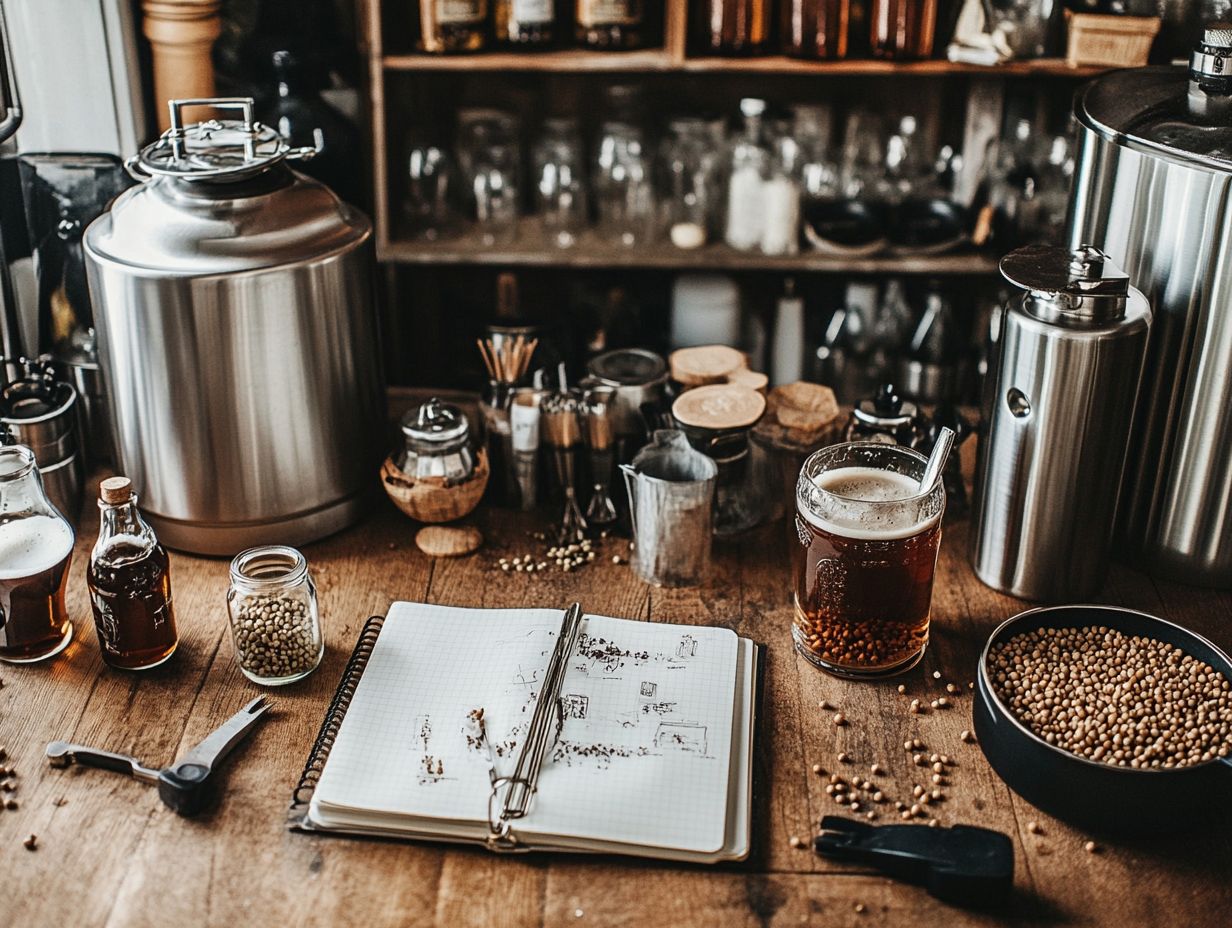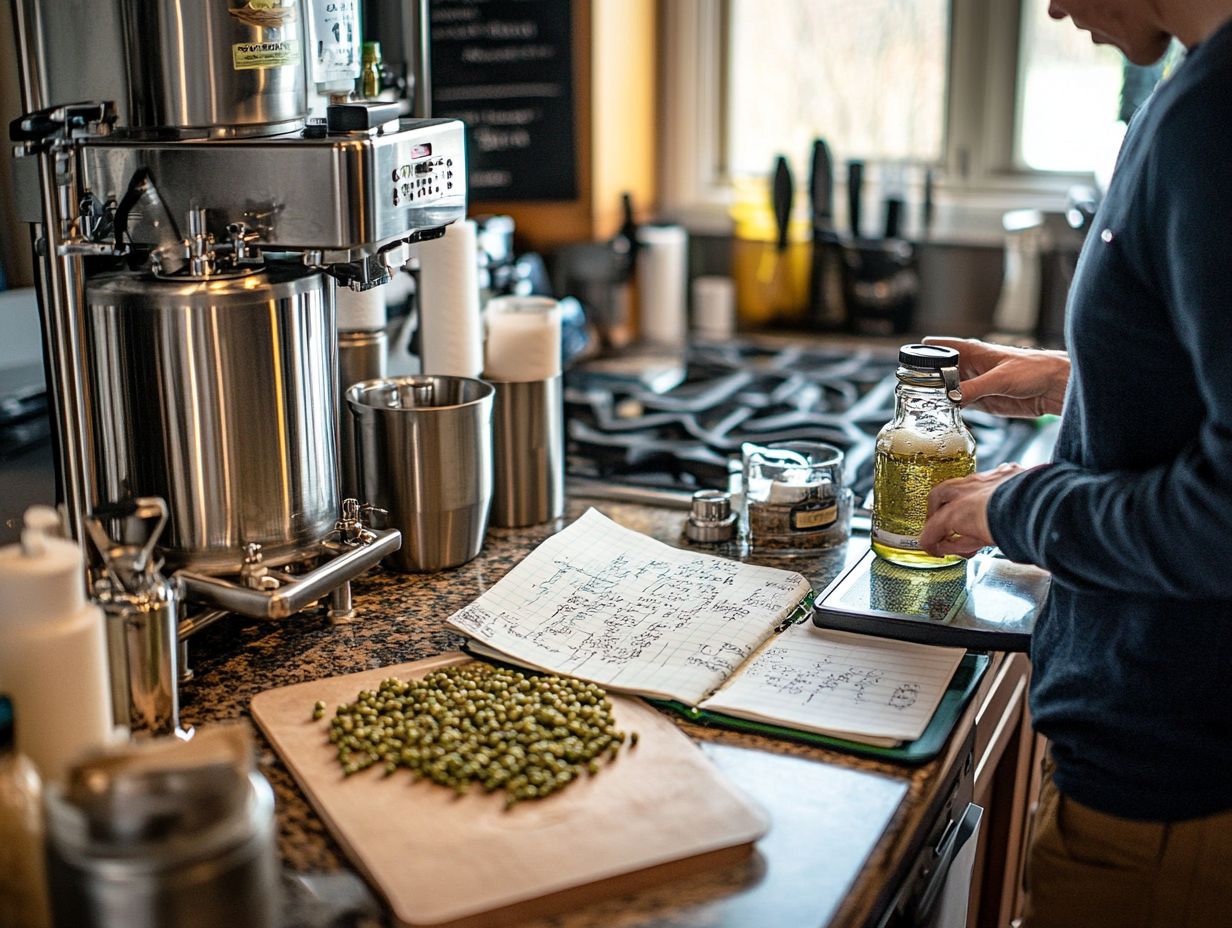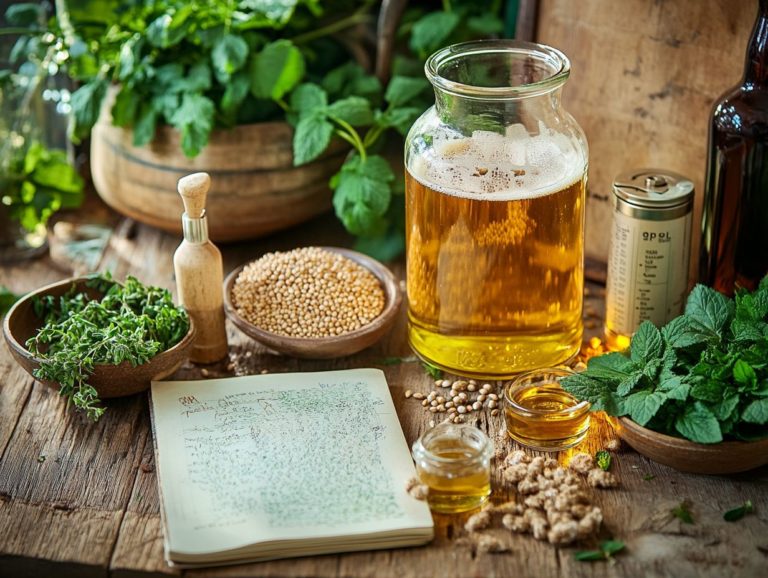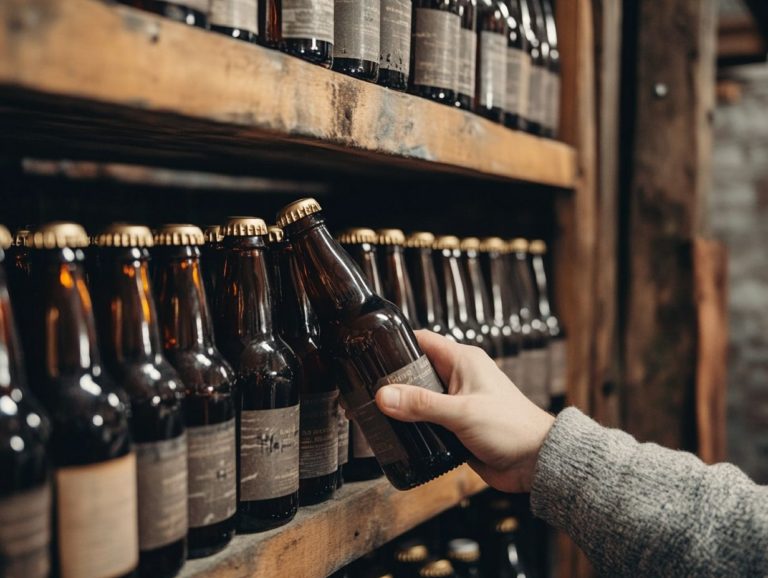Best Tips for Brewing High-ABV Beers
Contents
- The Art of Brewing High-ABV Beers: A Comprehensive Guide
- Key Takeaways:
- What are the Key Factors in Brewing High-ABV Beers?
- 3. Mashing Techniques
- 4. Boiling Techniques
- What are the Steps for Brewing High-ABV Beers?
- 1. Recipe Creation
- What are Some Tips for Successful High-ABV Beer Brewing?
- Frequently Asked Questions
- What are the best tips for brewing high-ABV beers?
- What are some common mistakes to avoid when brewing high-ABV beers?
- How important is the yeast strain in brewing high-ABV beers?
- Can I use regular brewing equipment for high-ABV beers?
- Are there any special techniques for achieving a higher alcohol content in beer?
- Can I age high-ABV beers like I would with other beers?
The Art of Brewing High-ABV Beers: A Comprehensive Guide
Brewing high-alcohol by volume (ABV) beers, also known as high-gravity beers, offers a blend of unique challenges and rewarding experiences that can entice both novice and seasoned brewers, including homebrewers. To craft these robust brews, it s vital to grasp key factors such as the selection of yeast and malt, as well as to master essential mashing and boiling techniques.
Dive into this guide to unlock the secrets of brewing! You will discover the critical steps in the brewing process, various techniques, and tips designed to enrich your experience, ensuring your high-ABV creations, like those inspired by Dogfish Head Brewery, stand out.
Prepare yourself to elevate your brewing game to new heights with essential brewing tips!
Key Takeaways:

- Choose the right yeast and malt for high-ABV beers, such as those used in big beers like Imperial Stout.
- Follow proper brewing steps: recipe creation, sanitation, mashing, boiling, cooling, fermentation, conditioning, and carbonation.
- Use a hydrometer, monitor temperature, oxygenate wort, and consider secondary fermentation for successful high-ABV beers.
What are the Key Factors in Brewing High-ABV Beers?
Brewing high-ABV beers, such as an Imperial Stout or other high-gravity varieties, demands keen expertise in a multitude of critical factors that shape the fermentation process. This includes key brewing variables and the science of brewing.
Elements like yeast health, alcohol tolerance, osmotic pressure (the pressure caused by the concentration of sugars), and the careful selection of specific yeast strains and yeast nutrients are crucial for reaching the desired alcohol content in these robust brews.
Whether you are a homebrewer or a professional, you must deftly navigate these complexities to ensure a successful brewing experience. This involves tackling common fermentation challenges such as managing oxygen levels and temperature control that may emerge along the way.
1. Yeast Selection
The choice of yeast is a pivotal aspect of the brewing process, especially when crafting high-ABV beers. Different yeast strains possess distinct fermentation capabilities and alcohol tolerances, making your selection critical.
Understanding yeast health is essential, as it directly impacts fermentation efficiency and the overall quality of your final product. Healthy yeast not only ferments sugars more effectively but also plays a significant role in developing desirable flavors and aromas, ultimately enhancing your drinking experience.
For those focusing on high-ABV styles, strains like Saccharomyces cerevisiae are often preferred due to their impressive performance under challenging conditions, including high sugar levels. Managing yeast propagation is crucial; it ensures a robust population for fermentation, minimizes off-flavors, and optimizes your brewing outcomes.
By prioritizing these elements, you can achieve consistent high-ABV beers. Understanding yeast hydration further enhances your brewing success.
2. Malt Selection
Malt selection is pivotal for brewing high-ABV beers, as the type and quality of malt you choose directly impact the sugar content, flavor profile, and body of your final product. For example, high-gravity beers often require malts that contribute to higher alcohol content.
Selecting the right malts can revolutionize your brewing process, especially when targeting higher alcohol levels. Ingredients like maltodextrin provide non-fermentable sugars, enhancing the mouthfeel without increasing the alcohol content, while lactose often found in milk stouts introduces a delightful sweetness and creamy texture.
This thoughtful selection not only tackles the challenges of fermentation, where a high ABV can occasionally cause yeast activity to stall, but also enriches the beer’s overall character. By skillfully blending various malt types and adjusting your brewing methods, you can create exceptional brews that strike a perfect balance and complexity, ensuring a truly delightful experience for beer enthusiasts, particularly those who appreciate craft beer.
3. Mashing Techniques
Mastering effective mashing techniques is essential for extracting fermentable sugars from malt. This factor significantly influences both brewing efficiency and the overall character of high alcohol by volume (ABV) beers. This is vital for brewing big beers that impress!
During this critical stage, maintaining optimal temperature control is crucial. Different enzymatic activities demand specific heat levels to convert starches into sugars. pH monitoring is also important; achieving the ideal acidity enhances enzyme performance and facilitates smoother mashing.
You have various methods to create these optimal conditions. For instance, employing step mashing allows you to gradually increase temperatures to target specific enzymes. Using temperature- and pH-sensitive sensors enables real-time adjustments. These strategies streamline the extraction process and contribute to the development of well-balanced flavors and aromas in your final product.
4. Boiling Techniques
Mastering boiling techniques is essential in the brewing process, especially for high-ABV beers. These techniques dictate how effectively you can introduce hops and unlock brewing secrets during production. Proper boiling tackles impurities and ensures a high-quality product.
The timing and method of adding hops are crucial. They significantly impact the extraction of essential oils and bitterness that shape the final flavor profile of your brew. You can add hops at various stages: during the boil for bitterness, at the end for aroma, or even post-boil for a refreshing burst of flavor. Understanding these methods can improve your brewing outcomes.
Each method influences the character of your beer and helps tackle fermentation challenges, such as impurities or unwanted flavors. By optimizing your boiling process and understanding key fermentation tips, you can ensure that your equipment operates at peak efficiency. This leads to improved yield and quality in every batch you craft.
What are the Steps for Brewing High-ABV Beers?

Brewing high-ABV beers is an art that requires your attention to detail at every stage. It starts with carefully crafting a recipe. Every ingredient, from brewing yeast to creative adjuncts, is thoughtfully selected to get the flavor you want.
As you move through the preparation and sanitation phases, each step plays a crucial role in ensuring a smooth fermentation process. By being meticulous, you set the stage for a finished product that exemplifies quality and craftsmanship, much like the celebrated Black Tuesday from The Bruery.
1. Recipe Creation
The foundation of any successful high-ABV beer begins with the art of recipe creation. You need to thoughtfully consider the balance of ingredients malt, hops, and perhaps some creative adjuncts to craft the perfect flavor profile. This aspect is often explored at the Craft Brewers Conference.
This balance is essential not just for achieving the right taste but also for ensuring that your beer remains drinkable despite its elevated alcohol content. Incorporating creative adjuncts enhances complexity by introducing unique flavors and aromas that truly elevate your brew. Thoughtful sugar additions can bolster fermentation, contributing to both body and mouthfeel while ensuring a smooth finish.
Exploring different brewing methods, like barrel aging or experimenting with various yeast strains and sugar additions, adds depth to your high-ABV creations. This approach allows you to cater to diverse palates, making the brewing journey all the more rewarding.
What’s your favorite brewing technique? Share your experiences and tips!
2. Preparation and Sanitation
Preparation and sanitation stand as essential pillars in the brewing process. You must meticulously clean and sanitize all brewing equipment, just as Sam Calagione of Dogfish Head emphasizes. This diligence prevents contamination and ensures a successful fermentation.
These practices not only protect the flavors and quality of your final product but also create an optimal environment for yeast to flourish. When you prioritize yeast management, addressing common fermentation challenges becomes significantly easier. By skillfully controlling variables such as temperature and pH levels, you can optimize yeast performance, resulting in a more consistent product.
Ultimately, when you execute both sanitation and yeast management with care, you dramatically increase the likelihood of crafting a desirable and successful batch of brew.
3. Mashing Techniques
Mashing is an important step in your brewing process. Here, you combine milled grains with water at specific temperatures to transform starches into fermentable sugars. This stage is pivotal for the entire fermentation process and influences overall brewing efficiency.
As you embark on this phase, maintaining precise temperature control is paramount. Different enzymes within the malt activate at varying temperatures. Typically, you’ll want to hold the mash between 145 F and 158 F to strike the perfect balance for optimal enzyme activity that efficiently breaks down starches into sugars.
Don’t overlook the importance of monitoring the pH of your mash, which is a measure of acidity. It significantly impacts enzyme performance and extraction efficiency. Aim for an ideal pH range of around 5.2 to 5.6, as this not only enhances sugar yield but also helps prevent any unwelcome flavors from creeping in. Monitoring pH levels is crucial for brewing success and can elevate your beer to new heights!
By diligently managing these parameters, including gravity readings measurements that help you understand the sugar concentration in your brew you can maximize sugar extraction. This leads to a more flavorful and well-balanced beer that reflects your careful craftsmanship.
4. Boiling and Hops Addition Techniques
The boiling stage of brewing is where you add hops, elevating your beer with bitterness and aroma. It also plays a crucial role in reaching the desired fermentation temperature and stability, especially in high-ABV beers.
This essential phase lays the groundwork for the entire brewing process. The timing and technique of your hops addition can significantly influence the final character of your brew. By introducing hops at various points during the boil, you create a spectrum of bitterness and aromatic qualities that ultimately shape your beer’s profile.
Boiling also sterilizes the wort, ensuring that your brewing environment remains pristine and free from unwanted bacteria. Grasping these intricacies enables you to unlock the secrets of your craft. With this knowledge, you can refine your recipes and craft unique flavor experiences that are sure to delight any beer enthusiast.
5. Cooling and Fermentation
Cooling the wort after boiling is an essential step in preparing for fermentation. It needs to reach the ideal fermentation temperature to ensure optimal yeast health and activity. Monitoring pH levels and oxygen levels during this step is crucial.
The cooling process generally involves swiftly reducing the wort’s temperature to a level suitable for yeast inoculation. This step is critical because yeast is quite sensitive to temperature changes. Excessive heat can harm or even kill them, while insufficient warmth can significantly slow their activity.
Controlling the fermentation temperature is vital for fostering healthy yeast growth and for shaping the flavors and aromas that develop during fermentation. By utilizing yeast management techniques and maintaining a stable temperature, you enable the yeast to efficiently convert sugars into alcohol and carbon dioxide. This ultimately influences the beer’s final characteristics, including clarity, flavor profile, and overall quality.
6. Conditioning and Carbonation

Conditioning and carbonation are vital final steps in brewing high-ABV beers. They allow flavors to mature while ensuring the perfect carbonation level.
These processes are essential for enhancing the beer s overall character and complexity. During conditioning, yeast works on the sugars, enriching the flavor profile with subtle notes of fruit, spice, or caramel.
Fermentation aging is equally important. It gives your brew time to mellow, softening rough edges and harmonizing flavors.
Patience can turn your beer into a smooth, aromatic experience, making each sip a captivating encounter for your palate.
What are Some Tips for Successful High-ABV Beer Brewing?
To brew high-ABV beers successfully, employ key tips that elevate your process. From mastering yeast management to monitoring gravity readings, these strategies guide you toward creating exceptional brews.
1. Use a Hydrometer
A hydrometer is essential for homebrewers. It measures density readings during fermentation, enabling better monitoring of alcohol content.
These readings indicate the fermentation stage. Understanding density helps you decide when to transfer the beer to a new container for clarity or adjust temperature conditions.
Accurate measurement of density impacts brewing efficiency. It helps avoid mishaps like over-carbonation or under-fermentation, ensuring your product meets the desired flavor profile and alcohol level.
2. Monitor Fermentation Temperature
Monitoring fermentation temperature is key to maintaining yeast health. It ensures the fermentation process unfolds seamlessly, minimizing issues.
Yeast activity is sensitive to temperature variations. Precise control affects flavor development, aroma, and the overall quality of your beer.
Effective temperature management enhances yeast performance and reduces unwanted byproducts. Creating a well-monitored fermentation environment results in superior beer that delights both you and your consumers.
3. Oxygenate the Wort
Oxygenating the wort before fermentation is an essential step that elevates yeast propagation and enhances the fermentation process, ensuring a healthy and vigorous fermentation. Proper oxygen levels are crucial for yeast vitality.
This practice significantly shapes the final flavor profile and aroma of your beer. There are various effective methods for introducing oxygen, such as using pure oxygen tanks, aeration stones, or simply shaking the fermenter after transferring the wort. Each method has its own efficiency and can produce distinct outcomes, profoundly impacting your brewing process.
By mastering these techniques, you can unlock the secrets to crafting a more robust beer, ultimately enriching its character and depth. These skills allow your beer to shine in a competitive market. Dive deeper into brewing science to unlock your beer’s full potential!
4. Consider a Secondary Fermentation
Considering a secondary fermentation can enhance the quality of your high-alcohol beers, allowing flavors to develop further and giving the yeast time to stabilize in a controlled environment. This practice is especially beneficial in brewing high-ABV beers.
This step elevates your beer’s overall profile and introduces a delightful array of flavors and aromas, enriching your drinking experience. By transferring your beer from the primary fermentation vessel to a secondary one, you can effectively eliminate sediment and unwanted byproducts that often accumulate during initial fermentation. This is an essential tip for brewing big beers.
This technique offers a perfect opportunity to incorporate various adjuncts ingredients added to enhance flavor such as fruits or spices. This allows their unique characteristics to meld into the beer, creating a rich tapestry of flavors. Secondary fermentation enhances carbonation levels and clarifies the beer, resulting in a cleaner, more refined finish that elevates the overall quality. This method is commonly used in craft beer circles.
5. Age the Beer Properly

Properly aging your beer is essential, especially for high-alcohol varieties. This process allows complex flavors to meld and mature, ultimately enhancing your overall drinking experience. High-alcohol beers often benefit from aging in bourbon barrels.
The art of fermentation aging involves several principles, where factors like temperature control, humidity, and time play pivotal roles. Most brewers recommend aging at cooler temperatures to slow down oxidation, preserving the beer s unique character while allowing flavors to develop beautifully.
High-ABV beers thrive with a longer aging period, resulting in a delightful symphony of tasting notes that can range from fruity and rich to earthy and nutty. Embracing these aging techniques can significantly enhance your brewing efficiency by integrating diverse flavors, allowing you to achieve complexity in the final product with fewer additional ingredients. Historical examples such as Thomas Hardy s Ale and H rlimann s Samichlaus showcase the benefits of extended aging.
Frequently Asked Questions
What are the best tips for brewing high-ABV beers?
To brew high-ABV beers, start with these key tips:
- Use a high-quality yeast strain.
- Add fermentable sugars.
- Control fermentation temperature.
- Use a hydrometer to measure gravity.
Attending the Craft Brewers Conference can also provide valuable brewing tips and insights.
What are some common mistakes to avoid when brewing high-ABV beers?
Common mistakes include:
- Using too much sugar.
- Not aerating the wort enough.
- Not giving the beer enough time to ferment and age properly.
- Mismanagement of brewing variables like osmotic pressure and pH levels.
How important is the yeast strain in brewing high-ABV beers?
The yeast strain is crucial in brewing high-ABV beers as it determines the alcohol tolerance and flavor profile. Choosing a high-quality, high-alcohol tolerant yeast is key. Successful brewers like Sam Calagione from Dogfish Head Brewery emphasize the importance of selecting the right yeast strains.
Ready to take your brewing to the next level? Start experimenting today!
Can I use regular brewing equipment for high-ABV beers?
While it is possible to use regular equipment, it is recommended to invest in equipment designed for brewing high-ABV beers, such as larger fermenters and stronger bottles. Brewers like Adam Avery from Avery Brewing suggest that specialized brewing equipment can better withstand the rigorous demands of high-alcohol beer production.
Are there any special techniques for achieving a higher alcohol content in beer?
One technique is to use a process called ‘step feeding,’ where fermentable sugars are added in stages during the fermentation process. This allows the yeast to gradually consume the sugars and produce a higher alcohol content. Incorporating brewing sugars like malto-dextrin and lactose can also enhance the final product.
Can I age high-ABV beers like I would with other beers?
Yes, aging high-ABV beers is important for allowing the flavors to develop and mellow out. High-alcohol beers, such as Imperial Stout or high-gravity beer, benefit greatly from the fermentation process. The Bruery’s Black Tuesday is a great example of such beer that ages well, often in bourbon barrels. It is recommended to age them for at least a few months before consuming.






